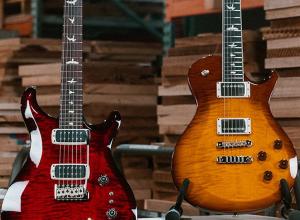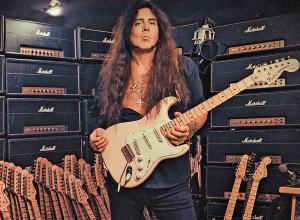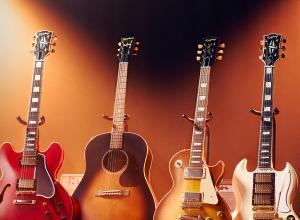Qual è la vera differenza tra una chitarra da 250.000 dollari e ? Perché nessuno, tranne pochi milionari, può permettersela.
Le chitarre vintage sono diventate un fenomeno perché a un certo punto, negli anni '70, hanno iniziato a essere riconosciute come l'apice della produzione degli storici costruttori di chitarre. Gli strumenti che hanno ispirato un gruppo di musicisti a creare musica iconica che è entrata a far parte della vita di milioni di persone.
Questa complessa interazione è purtroppo terminata da tempo, probabilmente quando questi musicisti hanno iniziato a sostituire le "vecchie chitarre" con repliche, copie nuove di zecca da utilizzare sul palco (Eric Clapton, Sting, Keith Richards, Slash solo per citarne alcuni...) e, negli anni più recenti, quando hanno smesso di fare tour o di registrare a causa dell'età.
Ma non solo: con il crescente sviluppo tecnologico dei computer e della musica digitale, l'amore per i vecchi oggetti, per esempio le chitarre elettriche e gli amplificatori valvolari, è diventato più un "culto" che qualcosa di largamente apprezzato da una massa di musicisti.
La produzione di massa... È proprio questo il problema principale che i marchi storici di chitarre non sono in grado di risolvere. Hanno bisogno di vendere articoli in serie per aumentare i profitti, ma in questo modo non possono concentrarsi su una produzione di eccellenza. Immaginate di ordinare una chitarra di alta qualità da John Monteleone: probabilmente ci vorrà un anno per la lista d'attesa e un paio d'anni per vederla completata.
Ecco perché probabilmente non vedremo mai la "magia" delle chitarre originali ricreata all'interno delle mura dei grandi nomi, perché le moderne fabbriche di chitarre non possono concentrarsi a sufficienza sulla qualità, hanno bisogno della quantità. E la quantità non può essere disturbata dall'eccellenza.
Sì, l'eccellenza nella costruzione e nei materiali è ciò che "ha fatto la magia" nel 1959 alla Gibson, per esempio. Ma l'attuale management dell'azienda non dovrebbe concentrarsi sulla ricreazione di questi ingredienti fondamentali, piuttosto che sulla vendita di chitarre vintage? Perché ci si può anche chiamare Gibson, ma se si diventa rivenditori di strumenti vintage ci si scontra con tutti gli stessi problemi: offrire una garanzia alle chitarre Gibson vendute attraverso il programma "Vintage" suona un po' strano, la fabbrica Gibson che costruiva quelle chitarre originali è ormai lontana, e queste chitarre non sono più giovani!
Cosa succederà al vostro prezioso investimento quando, come inevitabilmente accadrà, si romperà un pickup? Come farà il vostro pezzo di carta nuovo di zecca per la "certificazione" a correggerlo? Certo, Gibson può riavvolgerlo, ma poi? Utilizzeranno il filo, le procedure e i materiali corretti?
![Il vintage è morto. Lunga vita al vintage! [ITA - ENG] Il vintage è morto. Lunga vita al vintage! [ITA - ENG]](https://www.accordo.it/cloud-assets/00/redazionea5a/images/115032gibson-vintage.jpg)
L'intero progetto sarebbe molto più credibile se queste aziende adottassero lo stesso "Dipartimento di Restauro delle Belle Arti" che, per esempio, ha adottato Ferrari per le sue auto, dove i clienti possono avere la loro preziosa Ferrari d'epoca restaurata alla perfezione, in un ambiente di eccellenza di altissimo livello, ad assicurarle valore e originalità per il futuro.
Purtroppo l'arte del restauro nel mondo delle chitarre non è esistita negli ultimi decenni, per varie ragioni. Queste chitarre elettriche hanno "solo" 50, 60, 70 anni nella maggior parte dei casi, quindi per la maggior parte della loro vita sono state "solo chitarre", quando sono state vendute nuove di zecca, per poi diventare "chitarre per musicisti", che facevano il loro dovere sul palco, e in seguito "vecchie chitarre" quando i tempi del palco erano finiti. Quindi non c'è mai stata la necessità di un restauro professionale.
Solo negli ultimi anni il riconoscimento della necessità di curare l'eredità di questi strumenti musicali iconici è diventato una cosa molto importante per le persone, e restauratori professionisti, come Joel Wilkens (JW Guitar Restorations) di Philadelphia, negli Stati Uniti, o i liutai del ToneTeam in Italia, hanno lentamente contribuito con il loro lavoro a spiegare che la qualità e l'accuratezza sono le caratteristiche chiave per riportare questi strumenti iconici alla loro gloria incontaminata.
Rimane comunque la domanda: il "vintage" è ancora una cosa importante?
La nostra percezione è che le aziende produttrici di chitarre dovrebbero concentrarsi sulla costruzione di chitarre di alta qualità come quelle di una volta, perché non ci sarà alcun "vintage" in futuro se le aziende non si concentreranno sulla costruzione di prodotti di eccellenza. Le chitarre di alta qualità ispireranno sempre i musicisti con la loro musica e la magica connessione tra la musica, il musicista e gli strumenti utilizzati per registrarla è ciò che crea l'alchimia "Vintage".
Quindi, invece di cercare di rivendere vecchie chitarre di un passato glorioso, Gibson dovrebbe concentrarsi e vivere nel suo presente, perché nessun musicista che lavora può permettersi una chitarra vintage del passato con un costo che in alcuni casi è il doppio del valore di una casa di famiglia.
Qual è allora il futuro delle chitarre "vintage"? La maggior parte di questi strumenti storici ha ormai più di 50 anni, e sono una vera e propria parte della storia della musica contemporanea, e come tali devono essere protetti, studiati, e appartengono ai musei molto più che ai palcoscenici. Non sono diversi da uno Stradivari o da un Guarneri del Gesù, sono oggetti speciali che dovranno ispirare le future generazioni di costruttori o musicisti.
Quindi, in senso positivo, il "vintage" come lo conoscevamo è morto per davvero, perché la magica connessione tra un'epoca d'oro di artisti di incredibile talento e i loro strumenti è naturalmente giunta al termine. Il futuro di queste chitarre ormai storiche è nei musei, con laboratori speciali ed eventi dove poterle ascoltare in un ambiente sicuro, in modo molto simile a quanto avviene per gli antichi e inestimabili violini. Il futuro del "vintage" arriverà quando un'altra era magica e ispirata di musicisti creerà musica iconica per la gente.
--- ENG ---
![Il vintage è morto. Lunga vita al vintage! [ITA - ENG] Il vintage è morto. Lunga vita al vintage! [ITA - ENG]](https://www.accordo.it/cloud-assets/00/redazionea5a/images/110227burst01.jpg)
The Vintage is dead, long live the Vintage!
Gibson announces the “new” “Certified Vintage Program”, something that Fender already did during COVID with scarce success. Somebody is praising this attempt, some others don’t, but question is, why we should bother? What is the true difference between a 250,000 $ guitar and the same guitar advertised at 500,000 $ ? No one except millionaires can afford it.
Vintage Guitars became a thing because at some point in the 70s, they started to be recognised as the production’s craftmanship peak of historical guitar makers, which inspired a group of musicians to create iconic music that became part of the life of million people.
This complex interaction has, sadly, long ended, probably when those musicians started replacing the “old guitars” with replicas, copies, brand new ones to be used on stage (Eric Clapton, Sting, Keith Richards, Slash just to name a few…), and, in most recent years, when they stopped touring or recording because of age.
But not only that, with the increasing technology development of computers and digital music, the love for old items, Electric guitars and tube amps for example, has become more of a “cult” thing than something largely appreciated by a mass of musicians.
Mass production…that is exactly the main issue that the historical guitar brands aren’t able to solve. They need mass-production items to be sold to increase profit, but this way they can’t focus on a excellency production. Imagine ordering a high quality guitar from John Monteleone, it will probably take 1 year for the waiting list and a couple years to see it completed.
That is why we will probably never see the “magic” of the original guitars ever recreated inside the big names walls, because the modern guitar factories can’t focus too much on Quality, they NEED the Quantity, and quantity can’t be bothered by Excellence.
Yes, Excellence in Craftmanship and materials is what “made the magic” in 1959 at Gibson, for example, and the target of the current Company administration, should probably be focusing on recreating those fundamentals ingredients, rather than selling Vintage guitars? What is the point? You can call yourself “Gibson” but if you become a Vintage Dealer you will struggle with all the same problems, and offering a limited warranty to Gibson guitars sold through the Vintage program sounds a bit awkward, the “Gibson” factory who built those original guitars is long gone, and these guitars ain’t going to be any younger!
What’s going to happen to your prized investment once, as inevitably will happen, a pickup will break? How your brand new piece of paper for “Certification” will correct that? Of course Gibson can rewind it, but then? Will they use the correct wire, procedures, materials?
The whole project would achieve way more credibility if these companies would adopt the same Restoration Fine Arts Department as, for example, Ferrari did for his cars, where customers can have their prized Vintage Ferrari fully restored to perfection, in the highest level excellence environment, which would assure value and originality for the future.
Unfortunately the Art of Restoration in the guitar world has never been a thing in the past decades, for good reasons.
These Electric guitars are “Only” 50,60,70 years old in most cases, so for most of their life they were “just guitars”, when sold brand new, to become then “player’s guitars”, doing stage duty, and then later on “just old guitars” when the stage days were gone. So there has never really been a need for “Professional Restorations”.
Only in recent years the acknowledgement of the need of curating the heritage of these iconic musical instruments has become a very important thing to people, and Professional Restorers, as Joel Wilkens (JW Guitar Restorations) in Philadelphia, US, or the ToneTeam Luthiers in Italy, have slowly contributed with their work to explain that Quality and Accuracy are the key features to bring back these iconic instruments to their pristine glory.
Still, the question remain, is “Vintage” still a thing?
Our perception is that Guitar Companies should focus in building high quality guitars like they used to make, because there won’t be any “Vintage” in the future if they don’t focus in building Excellence with their products. Fine crafted guitars will always inspire musicians with their music, and the magical connection between music, musician and the instruments used to record it is what creates the “Vintage” Alchemy.
So, instead of trying to resell Old guitars from a Glorius past, Gibson should focus and lives in its present, because no working musician can afford a “Vintage guitar from the past” with a cost that in some case is double the value of a family house.
Which is then the future of “Vintage” guitars? Most of these historical instruments are now over 50 years old, and a real part of the History of contemporary music, and as such they need to be protected, studied, and they absolutely belongs to Museums much more than stages. They’re no different than a Stradivari or a Guarneri del Gesù, they are special items that will have to inspire future generations of builders or musicians.
So, in a good way, the “Vintage” as we used to know it is “Dead” for real, because the magical connection between a Golden Era of incredible talented artist and their instruments has naturally come to an end. The future of these now “historical” guitars belongs in Museums, with special laboratories, and Events where to hear these playing in a safe environment, in a very similar way like it happens with ancient and priceless Violins. The “future” of Vintage will arrive when another magical and inspired Era of musicians will create iconic music for the people. |
 VINTAGE VAULT
VINTAGE VAULT
 SHG MUSIC SHOW
SHG MUSIC SHOW
 PEOPLE
PEOPLE
 STORE
STORE
 - Privacy - Accordo.it Srl - P.IVA 04265970964
- Privacy - Accordo.it Srl - P.IVA 04265970964
![Il vintage è morto. Lunga vita al vintage! [ITA - ENG] Il vintage è morto. Lunga vita al vintage! [ITA - ENG]](https://www.accordo.it/cloud-assets/730x450/redazionea5/images/deco/105122_burst03.jpg)
![Il vintage è morto. Lunga vita al vintage! [ITA - ENG] Il vintage è morto. Lunga vita al vintage! [ITA - ENG]](https://www.accordo.it/cloud-assets/00/redazionea5a/images/115032gibson-vintage.jpg)
![Il vintage è morto. Lunga vita al vintage! [ITA - ENG] Il vintage è morto. Lunga vita al vintage! [ITA - ENG]](https://www.accordo.it/cloud-assets/00/redazionea5a/images/110227burst01.jpg)















